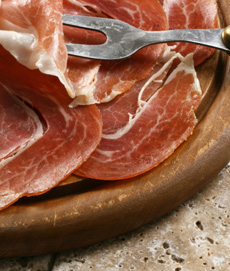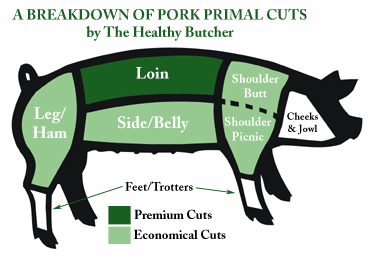
April 2010
Last Updated December 2023
|
 |
Pork Cuts & Pork Products Glossary
Page 8: Salami, Sausage, Serrano Ham & Other Pork Definitions With Sa To Sm
This is Page 8 of a nine-page glossary, including terms such as salami, sausage, Serrano ham, and smoking. Click on the black links below to visit other pages. See our 60+ other food glossaries.
This glossary is protected by copyright and cannot be copied in whole or in part.
Chart courtesy TheHealthyButcher.com. For a more detailed chart, see Page 1.
SALAMI/SALAME
Salami is a type of Italian aged, cured pork sausage; cured means that it is eaten without further cooking (fresh, or raw sausages, must be cooked). Its accurate name in Italian is un salame (SAH-la-meh), for a single salame; the plural is salami (SAH-la-mee). It became Americanized as salami and salamis (just as panino, the correct form for a single sandwich, is called by its plural form, panini, and the Americanized plural, paninis). The word salame comes from the Vulgar Latin, salamen, from the Latin salare, to salt.
|
SALUME and SALUMERIA
Italian for cold cut. Mortadella and prosciutto are examples. A salumeria is an Italian delicatessen.
SAUSAGE
Sausage is a food made from ground meat and fatback along with other flavorings such as herbs, spices, and sometimes wine. The ground meat used is most often pork, but there are endless combinations of ground meat that can be successfully used. Game sausages, such as venison, lamb, or rabbit usually use a half-game and half-pork ratio to ease the strong gaminess of the meat.
|
|
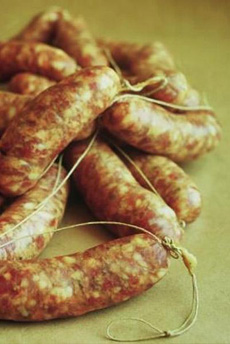
Classic Italian sausage is handmade to order at FraMani.com. |
|
SCRAPPLE
Scrapple is a breakfast meat product, popularly served with eggs or pancakes—or even by itself, with maple syrup. The product was originally developed to make use of pork scraps and trimmings that would have gone to waste (including the fat, heart, liver, and skin). These are combined with cornmeal, wheat, or buckwheat flour, and spices into a mush, that is formed into a loaf. Slices of the scrapple are cut and pan-fried. The result is a breakfast pattie that is crisp on the outside and soft on the inside. Scrapple is best known as a regional country food of the mid-Atlantic states, particularly the Pennsylvania Dutch region.
|
|
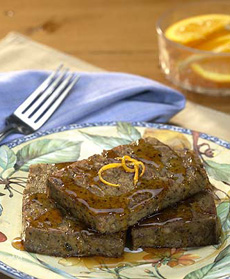
Time for breakfast! Photo courtesy Kaiser Family.
|
|
SERRANO HAM
Jamón serrano (literally mountain ham), or Serrano ham, is produced from the white pigs of Spain. The fresh ham of the white pig is salted, hung in cool sheds, cured, and aged for at least nine months. It is a tapas favorite (it is sliced from the whole leg at tapas bars) and is a key ingredient in stews. It is used to flavor artichokes, green beans, and tortilla española, a Spanish omelet. The Spanish version of ham and cheese is Serrano ham and Manchego cheese. (Try it as a grilled cheese on toast!) Serrano ham is generally moister and more flavorful than its Italian cousin, prosciutto.
|
|
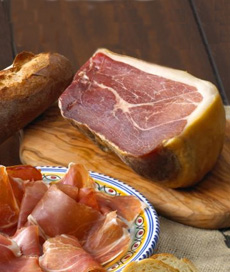
A boneless serrano ham from LaTienda.com. |
|
SHANK
Mild in flavor, shank pieces are an excellent way to season soups, beans/legumes, and other vegetables. They are also becoming popular as a braised cut.
SHOULDER
The shoulder, or pork butt, is very popular for sausages and charcuterie because of its large amount of fat. It is also a popular cut for barbecue and braising. See pork butt.
SKIN
See cracklings.
SIRLOIN
See loin of pork.
|
|
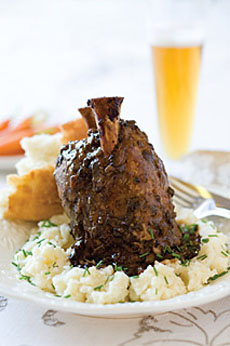
Braised pork shank available ready to heat and eat from MackenzieLtd.com. |
|
SLAB BACON
Slab bacon is one large chunk of meat that must be sliced. It is typically cheaper per pound than presliced bacon and usually has a rind, which should be removed before slicing. Slab bacon sliced by hand is invariably thicker than presliced bacon, which is machine-cut.
SLICED BACON
Sliced bacon has been trimmed of the rind, sliced, and packaged. Thin-sliced bacon has slices about 35 strips per pound, regular bacon has 16 to 20 strips per pound and thick-sliced bacon has 12 to 16 per pound.
|
|
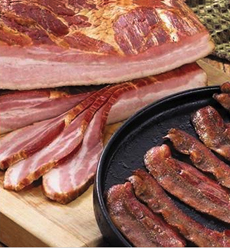
Slab bacon from Nueskes.com. |
SMOKED LIVER SAUSAGE
See liver sausage.
|
SMOKING
Smoking is a method of preservation, flavoring, and/or cooking meat and fish by exposing the protein to smoke, most often wood. Different woods—alder, apple, cherry, maple, etc.—give different flavor accents to the meat, and are variously paired (for example, mesquite provides a very heavy flavor and should be used to grill meats that cook for a very short period). The ham, or rear leg of the pig, can be roasted like other parts of the pig, for a delicious pork roast (known as fresh ham). However, to become a ham, it must be aged, cured, or smoked (pancetta and prosciutto are both cured and aged).
|
|
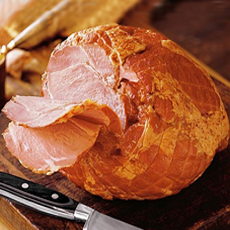
Smoked country ham from Zabars.com. |
- Brine-cured (wet-cured) hams have been injected with a combination of salt, sugar, flavorings, water, and preservatives (sodium nitrite, sodium erythorbate, sodium phosphate, potassium chloride). The ham is then cooked to a temperature of 150°F; the combination of the brine and the heat kills the bacteria. This is the fastest and least expensive method and is how most mass-marketed hams are cooked.
- Hot smoking cooks the ham in a controlled environment of smoke and heat, between 165°F and 185°F (74°C and 85°C). The products are safe to eat without further cooking. Artisan hams are generally hot-smoked.
- Cold smoking imparts smoky flavors to items such as pork chops, beef, chicken, or fish without cooking them. The item is smoked for a short period, just enough time to impart flavor, and then finished by using hot methods such as grilling, roasting, or baking to the desired doneness. Smokehouse temperatures for cold smoking should be maintained below 100°F (38°C). In this temperature range, foods take on a rich, smoky flavor, develop a deep mahogany color, and tend to retain a relatively moist texture. They are not cooked as a result of the smoking process, however. To receive a cold smoke, the meat is separated from the heating element in a separate chamber. The smoke from the heat source then travels through the chamber to the meat without the heat.
- Smoke-roasting or smoke-baking is the smoking method also known as barbecuing, pit-roasting, and pit-baking. It can be done in a smoker, smoke-roaster, closed barbecue pit, or wood-fired oven at above 250°F (121°C). Those without special equipment can use a conventional oven, placing a pan of hardwood chips on the bottom to produce a smoke bath.
Continue To Next Page: Pork Definitions So To Z
Go To The Article Index Above
Lifestyle Direct, Inc. All rights reserved. Photos are the copyright of their respective owners.

|




